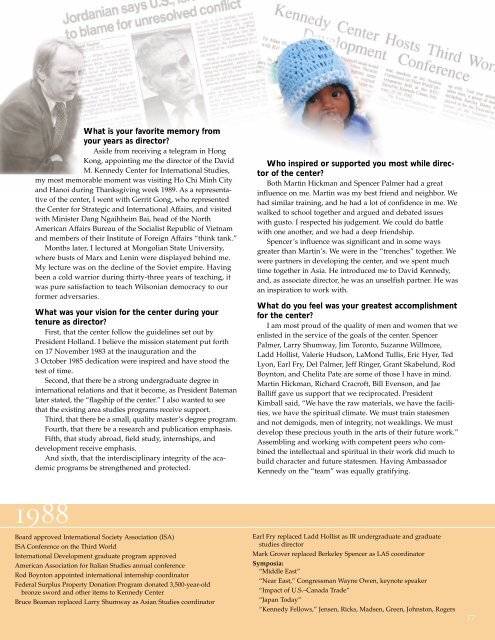BRIDGES - Kennedy Center - Brigham Young University
BRIDGES - Kennedy Center - Brigham Young University
BRIDGES - Kennedy Center - Brigham Young University
Create successful ePaper yourself
Turn your PDF publications into a flip-book with our unique Google optimized e-Paper software.
What is your favorite memory from<br />
your years as director?<br />
Aside from receiving a telegram in Hong<br />
Kong, appointing me the director of the David<br />
M. <strong>Kennedy</strong> <strong>Center</strong> for International Studies,<br />
my most memorable moment was visiting Ho Chi Minh City<br />
and Hanoi during Thanksgiving week 1989. As a representative<br />
of the center, I went with Gerrit Gong, who represented<br />
the <strong>Center</strong> for Strategic and International Affairs, and visited<br />
with Minister Dang Ngaihheim Bai, head of the North<br />
American Affairs Bureau of the Socialist Republic of Vietnam<br />
and members of their Institute of Foreign Affairs “think tank.”<br />
Months later, I lectured at Mongolian State <strong>University</strong>,<br />
where busts of Marx and Lenin were displayed behind me.<br />
My lecture was on the decline of the Soviet empire. Having<br />
been a cold warrior during thirty-three years of teaching, it<br />
was pure satisfaction to teach Wilsonian democracy to our<br />
former adversaries.<br />
What was your vision for the center during your<br />
tenure as director?<br />
First, that the center follow the guidelines set out by<br />
President Holland. I believe the mission statement put forth<br />
on 17 November 1983 at the inauguration and the<br />
3 October 1985 dedication were inspired and have stood the<br />
test of time.<br />
Second, that there be a strong undergraduate degree in<br />
international relations and that it become, as President Bateman<br />
later stated, the “flagship of the center.” I also wanted to see<br />
that the existing area studies programs receive support.<br />
Third, that there be a small, quality master’s degree program.<br />
Fourth, that there be a research and publication emphasis.<br />
Fifth, that study abroad, field study, internships, and<br />
development receive emphasis.<br />
And sixth, that the interdisciplinary integrity of the academic<br />
programs be strengthened and protected.<br />
1988<br />
Board approved International Society Association (ISA)<br />
ISA Conference on the Third World<br />
International Development graduate program approved<br />
American Association for Italian Studies annual conference<br />
Rod Boynton appointed international internship coordinator<br />
Federal Surplus Property Donation Program donated 3,500-year-old<br />
bronze sword and other items to <strong>Kennedy</strong> <strong>Center</strong><br />
Bruce Beaman replaced Larry Shumway as Asian Studies coordinator<br />
Who inspired or supported you most while director<br />
of the center?<br />
Both Martin Hickman and Spencer Palmer had a great<br />
influence on me. Martin was my best friend and neighbor. We<br />
had similar training, and he had a lot of confidence in me. We<br />
walked to school together and argued and debated issues<br />
with gusto. I respected his judgement. We could do battle<br />
with one another, and we had a deep friendship.<br />
Spencer’s influence was significant and in some ways<br />
greater than Martin’s. We were in the “trenches” together. We<br />
were partners in developing the center, and we spent much<br />
time together in Asia. He introduced me to David <strong>Kennedy</strong>,<br />
and, as associate director, he was an unselfish partner. He was<br />
an inspiration to work with.<br />
What do you feel was your greatest accomplishment<br />
for the center?<br />
I am most proud of the quality of men and women that we<br />
enlisted in the service of the goals of the center. Spencer<br />
Palmer, Larry Shumway, Jim Toronto, Suzanne Willmore,<br />
Ladd Hollist, Valerie Hudson, LaMond Tullis, Eric Hyer, Ted<br />
Lyon, Earl Fry, Del Palmer, Jeff Ringer, Grant Skabelund, Rod<br />
Boynton, and Chelita Pate are some of those I have in mind.<br />
Martin Hickman, Richard Cracroft, Bill Evenson, and Jae<br />
Balliff gave us support that we reciprocated. President<br />
Kimball said, “We have the raw materials, we have the facilities,<br />
we have the spiritual climate. We must train statesmen<br />
and not demigods, men of integrity, not weaklings. We must<br />
develop these precious youth in the arts of their future work.”<br />
Assembling and working with competent peers who combined<br />
the intellectual and spiritual in their work did much to<br />
build character and future statesmen. Having Ambassador<br />
<strong>Kennedy</strong> on the “team” was equally gratifying.<br />
Earl Fry replaced Ladd Hollist as IR undergraduate and graduate<br />
studies director<br />
Mark Grover replaced Berkeley Spencer as LAS coordinator<br />
Symposia:<br />
“Middle East”<br />
“Near East,” Congressman Wayne Owen, keynote speaker<br />
“Impact of U.S.–Canada Trade”<br />
“Japan Today”<br />
“<strong>Kennedy</strong> Fellows,” Jensen, Ricks, Madsen, Green, Johnston, Rogers<br />
17


